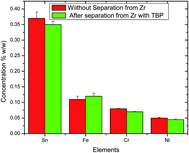Low cost and rapid analytical technique for determination of niobium and titanium in zirconium alloy
Abstract
A low cost and rapid analytical technique was developed for determination of major and minor constituents in

* Corresponding authors
a
Analytical Chemistry Division, Bhabha Atomic Research Centre, Trombay, Mumbai, India
E-mail:
rsinghal@barc.gov.in
Fax: +91-22-25505151
Tel: +91-22-25592233
A low cost and rapid analytical technique was developed for determination of major and minor constituents in

 Please wait while we load your content...
Something went wrong. Try again?
Please wait while we load your content...
Something went wrong. Try again?
M. K. T. Bassan, P. K. Sharma and R. K. Singhal, Anal. Methods, 2010, 2, 1559 DOI: 10.1039/C0AY00238K
To request permission to reproduce material from this article, please go to the Copyright Clearance Center request page.
If you are an author contributing to an RSC publication, you do not need to request permission provided correct acknowledgement is given.
If you are the author of this article, you do not need to request permission to reproduce figures and diagrams provided correct acknowledgement is given. If you want to reproduce the whole article in a third-party publication (excluding your thesis/dissertation for which permission is not required) please go to the Copyright Clearance Center request page.
Read more about how to correctly acknowledge RSC content.
 Fetching data from CrossRef.
Fetching data from CrossRef.
This may take some time to load.
Loading related content
